胶乳微球的粒径选择
致敏胶乳颗粒制备过程粒径控制对免疫比浊试剂性能影响研究

致敏胶乳颗粒制备过程粒径及分散指数的控制对免疫比浊试剂性能影响研究生化诊断是医院检验科最为常见的诊断平台,具有准确度高、精密度好及试剂性能稳定等特点,而胶乳增强免疫比浊法又是生化诊断平台中运用最为广泛的一种方法,能大大提高生化检验的分析灵敏度,在临床诊断中得到了广泛的运用。
胶乳致敏颗粒的制备过程如下:将抗体与聚苯乙烯纳米羧基微球在特定的缓冲液中孵育,加入一定量羧基活化剂,使得IgG分子N-端的氨基与微球表面的羧基发生共价偶联,形成牢固的酰胺键,最终微球表面被包被了一层IgG,可与人血清样本中相应的抗原发生抗原抗体反应而致敏。
然而在包被抗体过程中,由于所处缓冲体系的变化、包被IgG等电点与Buffer PH相近等原因,微球表面原先的电荷平衡会被打破,导致纳米微球粒子之间会发生一些可逆性的聚集,使得纳米微球粒径增大为裸球的几倍甚至数十倍,直至微球聚集沉淀。
同时,由于颗粒之间的聚集程度不一致,导致整个胶体溶液体系的均一性很差,分散度不好。
粒径增大及分散度变差的胶乳致敏颗粒会严重影响试剂的性能,如灵敏度降低、线性范围变窄及稳定性变差等。
这时,除了选择合适的胶乳储存液之外,我们还需要用超声波细胞破碎机将团聚的胶乳颗粒用超声波打散并实时监测其粒径及分散指数的变化,直至其下降到能满足试剂相应的性能指标要求为止。
然而,如果超声能量过大或者时间过长,虽然能使微球粒径及分散指数降至很低的水平甚至接近裸球的水平,但是超声波的高能量会对微球表面包被的IgG分子有一定的破坏,使得致敏胶乳颗粒失效。
综上所述,我们在超声过程中需要不断监测胶乳颗粒粒径及分散指数的变化,找到一个合适的范围,既能保证试剂的各项性能指标要求,又能及时终止超声过程以减少其对IgG分子的破坏,保证抗体的生物活性。
本研究以人血清肌红蛋白检测用致敏胶乳颗粒的制备过程为例,通过大量实验数据阐明在胶乳颗粒制备过程中粒径及分散指数的控制对最终试剂性能的影响。
本研究中用到的主要原料及仪器如下:原料及仪器名称厂家规格/批号/型号羊抗人肌红蛋白多克隆抗体北京阿匹斯生物生物技术有限公司批号:20160506聚苯乙烯羧基纳米微球JSR Life Sciences规格:P0219超声波细胞破碎机南京先欧仪器制造有限公司型号:XO-900D 粒径分析仪济南微钠型号:Winner802全自动生化分析仪长春迪瑞CS-1200本研究的实验方法如下:将制备好的人血清肌红蛋白检测用致敏胶乳颗粒进行冰浴超声,每隔10min取样测试粒径(单位为nm)及分散指数(以粒径仪测值*10000表示)(粒径仪事先进行校准),实验结果如下:由上图可知,随着超声时间的延长,粒径及分散度迅速下降,约20min之后达到一个平台期,粒径及分散度下降缓慢。
乳液聚合中乳胶粒粒径大小的影响因素
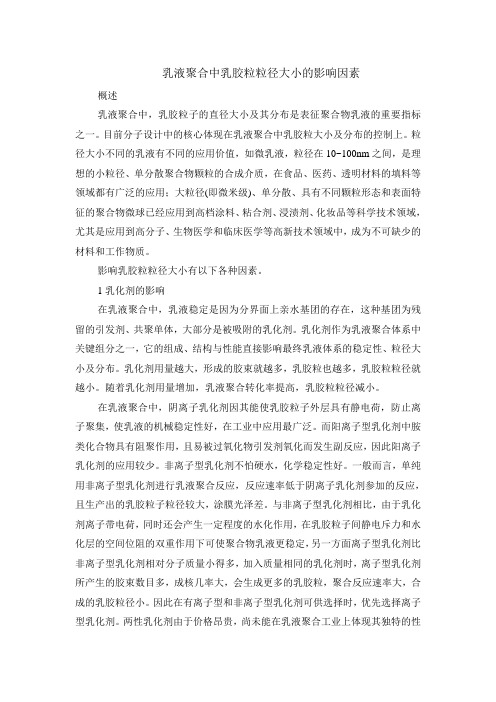
乳液聚合中乳胶粒粒径大小的影响因素概述乳液聚合中,乳胶粒子的直径大小及其分布是表征聚合物乳液的重要指标之一。
目前分子设计中的核心体现在乳液聚合中乳胶粒大小及分布的控制上。
粒径大小不同的乳液有不同的应用价值,如微乳液,粒径在 10~100nm 之间,是理想的小粒径、单分散聚合物颗粒的合成介质,在食品、医药、透明材料的填料等领域都有广泛的应用;大粒径(即微米级)、单分散、具有不同颗粒形态和表面特征的聚合物微球已经应用到高档涂料、粘合剂、浸渍剂、化妆品等科学技术领域,尤其是应用到高分子、生物医学和临床医学等高新技术领域中,成为不可缺少的材料和工作物质。
影响乳胶粒粒径大小有以下各种因素。
1乳化剂的影响在乳液聚合中,乳液稳定是因为分界面上亲水基团的存在,这种基团为残留的引发剂、共聚单体,大部分是被吸附的乳化剂。
乳化剂作为乳液聚合体系中关键组分之一,它的组成、结构与性能直接影响最终乳液体系的稳定性、粒径大小及分布。
乳化剂用量越大,形成的胶束就越多,乳胶粒也越多,乳胶粒粒径就越小。
随着乳化剂用量增加,乳液聚合转化率提高,乳胶粒粒径减小。
在乳液聚合中,阴离子乳化剂因其能使乳胶粒子外层具有静电荷,防止离子聚集,使乳液的机械稳定性好,在工业中应用最广泛。
而阳离子型乳化剂中胺类化合物具有阻聚作用,且易被过氧化物引发剂氧化而发生副反应,因此阳离子乳化剂的应用较少。
非离子型乳化剂不怕硬水,化学稳定性好。
一般而言,单纯用非离子型乳化剂进行乳液聚合反应,反应速率低于阴离子乳化剂参加的反应,且生产出的乳胶粒子粒径较大,涂膜光泽差。
与非离子型乳化剂相比,由于乳化剂离子带电荷,同时还会产生一定程度的水化作用,在乳胶粒子间静电斥力和水化层的空间位阻的双重作用下可使聚合物乳液更稳定,另一方面离子型乳化剂比非离子型乳化剂相对分子质量小得多,加入质量相同的乳化剂时,离子型乳化剂所产生的胶束数目多,成核几率大,会生成更多的乳胶粒,聚合反应速率大,合成的乳胶粒径小。
免疫比浊胶乳颗粒使用资料

免疫比浊胶乳颗粒使用胶乳微球使用中常见问题及解答问:产品说明书中给出的胶乳粒径是平均粒径吗?答:产品说明书中给出的胶乳粒径(Diameter)是平均粒径。
问:如何选择胶乳微球的粒径?答:一般选择粒径小的胶乳微球,则需要的抗体量就多,精密度和线性相对较好,而选择粒径大的胶乳微球性,则所需抗体少,精密度和线性相对较差,相对于小球,大球的灵敏度较好。
问:一般情况下我们所使用的微球的浓度大概是多少?答:整个测定体系中,微球的浓度大约在 0.01%左右,当然这与试剂本身规定的线性有关系。
问:在使用离心方法偶联乳胶微球,一般需要多大的(相对)离心力?答:需要多大的离心力和所使用的乳胶微球有关,一般 70nm 左右的微球大概13000g/min 30min 以上,粒径越小所需时间越长,离心力越大。
问:蛋白(抗体)与微球偶联前,是不是微球的活化时间越长,效率越好?答:羧基微球的活化所需时间很短,一般以 10-20 分钟为宜,长时间的活化反而会降低偶联效率。
问:由于抗体不只是 FC 的氨基酸上有 NH2,是不是表示它可以在任何方向与EDCA 活化微球偶联呢?如果是这样,是不是会影响抗体与抗原的特异性反应?答:事实的确如此,当然由于抗体的空间折叠方式和 FC 端疏水性强,因此偶联反应的绝大多数发生在 Fc 端,对抗体与抗原的结合的影响不大。
问:胶乳微球与抗体偶联后,当时没发现有凝集,但隔夜后发现有凝集,这是什么原因?如何控制和避免?答:这种情况一般是偶联效率低的原因。
当体系中蛋白不足或是其它原因,使微球表面在交联后还空出许多反应基团时,这些基团又可以与相连微球上的蛋白反应,结果是把球又拉在一起了,所以有聚集。
可以加一些阻断剂解决,常见的是 BSA,另外,也可提高微球的交联率。
但为什么是过一段时间后才出现凝集呢,这是因为微球偶联上蛋白后,相互之间由于携带同种电荷的关系,比较稳定(所以能以胶体样存在),只有当偶尔相互碰撞,遇上彼此的反应基团时才能结合。
明胶微球粒径控制的研究
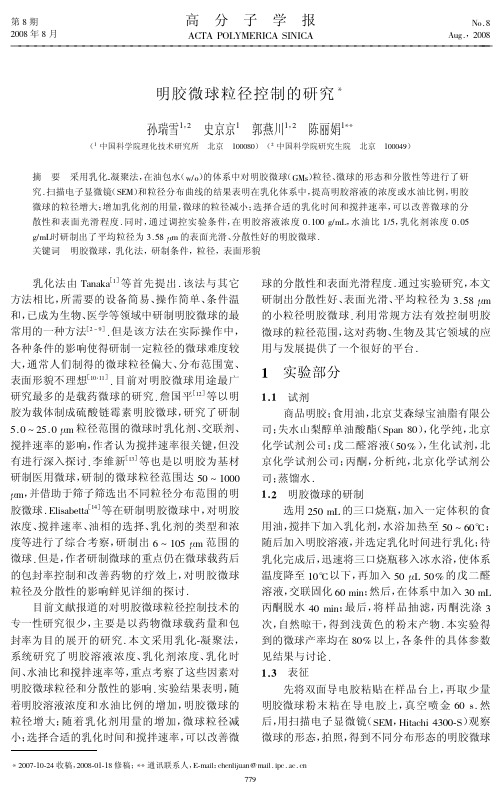
常用的一种方法
[! E 6]
!
!"!
实验部分
试剂 商品明胶; 食用油, 北京艾森绿宝油脂有限公
交联剂、 A>" E !A>" ! ) 粒径范围的微球时乳化剂、 搅拌速率的影响, 作者认为搅拌速率很关键, 但没
[%B] 有进行深入探讨 4 李维新 等也是以明胶为基材
司; 失水山梨醇单油酸酯 ( =5*0 ’") , 化学纯, 北京 化学试剂公司; 戊二醛溶液 ( A"I ) , 生化试剂, 北 京化学试剂公司; 丙酮, 分析纯, 北京化学试剂公 司; 蒸馏水 4 !"# 明胶微球的研制 选用 !A" )@ 的三口烧瓶, 加入一定体积的食 用油, 搅拌下加入乳化剂, 水浴加热至 A" E H"J ; 随后加入明胶溶液, 并选定乳化时间进行乳化; 待 乳化完成后, 迅速将三口烧瓶移入冰水浴, 使体系 温度降至 %"J 以下, 再加入 A" ! @ A"I 的戊二醛 溶液, 交联固化 H" )+0; 然后, 在体系中加入 B" )@ 丙酮脱水 &" )+0; 最后, 将样品抽滤, 丙酮洗涤 B 次, 自然晾干, 得到浅黄色的粉末产物 4 本实验得 到的微球产率均在 ’"I 以上, 各条件的具体参数 见结果与讨论 4 !"$ 表征 先将双面导电胶粘贴在样品台上, 再取少量 明胶微球粉末粘在导电胶上, 真空喷金 H" < 4 然 后, 用扫描电子显微镜 ( =(;, 观察 K+G*-.+ &B""$=) 微球的形态, 拍照, 得到不同分布形态的明胶微球
01$. 234 =17&4845 =1A851LK819: 9; ?@A ;95&4= 1: !"!#! 01$. # 234 CI@ 1&7$4 9; ?@A ;95&4= 1: !"!#! $%&’ 4&K6A1;145 <9:<4:857819:
胶乳微球偶联蛋白的使用中常见问题及解答
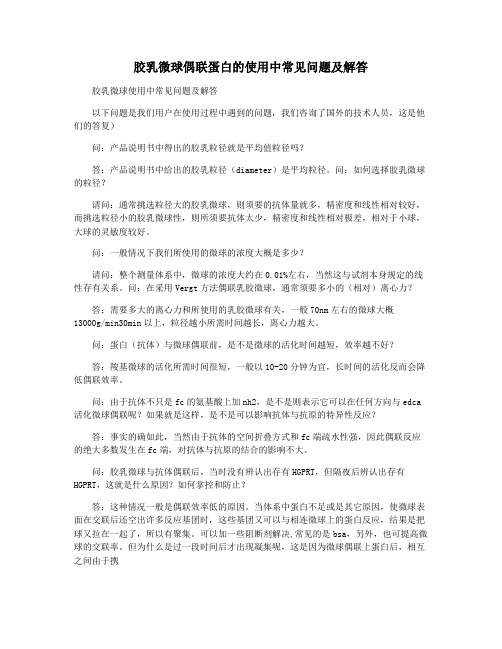
胶乳微球偶联蛋白的使用中常见问题及解答胶乳微球使用中常见问题及解答以下问题是我们用户在使用过程中遇到的问题,我们咨询了国外的技术人员,这是他们的答复)问:产品说明书中得出的胶乳粒径就是平均值粒径吗?答:产品说明书中给出的胶乳粒径(diameter)是平均粒径。
问:如何选择胶乳微球的粒径?请问:通常挑选粒径大的胶乳微球,则须要的抗体量就多,精密度和线性相对较好,而挑选粒径小的胶乳微球性,则所须要抗体太少,精密度和线性相对极差,相对于小球,大球的灵敏度较好。
问:一般情况下我们所使用的微球的浓度大概是多少?请问:整个测量体系中,微球的浓度大约在0.01%左右,当然这与试剂本身规定的线性存有关系。
问:在采用Vergt方法偶联乳胶微球,通常须要多小的(相对)离心力?答:需要多大的离心力和所使用的乳胶微球有关,一般70nm左右的微球大概13000g/min30min以上,粒径越小所需时间越长,离心力越大。
问:蛋白(抗体)与微球偶联前,是不是微球的活化时间越短,效率越不好?答:羧基微球的活化所需时间很短,一般以10-20分钟为宜,长时间的活化反而会降低偶联效率。
问:由于抗体不只是fc的氨基酸上加nh2,是不是则表示它可以在任何方向与edca 活化微球偶联呢?如果就是这样,是不是可以影响抗体与抗原的特异性反应?答:事实的确如此,当然由于抗体的空间折叠方式和fc端疏水性强,因此偶联反应的绝大多数发生在fc端,对抗体与抗原的结合的影响不大。
问:胶乳微球与抗体偶联后,当时没有辨认出存有HGPRT,但隔夜后辨认出存有HGPRT,这就是什么原因?如何掌控和防止?答:这种情况一般是偶联效率低的原因。
当体系中蛋白不足或是其它原因,使微球表面在交联后还空出许多反应基团时,这些基团又可以与相连微球上的蛋白反应,结果是把球又拉在一起了,所以有聚集。
可以加一些阻断剂解决,常见的是bsa,另外,也可提高微球的交联率。
但为什么是过一段时间后才出现凝集呢,这是因为微球偶联上蛋白后,相互之间由于携拎同种电荷的关系,比较稳定(所以能够以胶体样存有),只有当偶尔相互相撞,碰上彼此的反应基团时就可以融合。
胶乳微球吸附原理
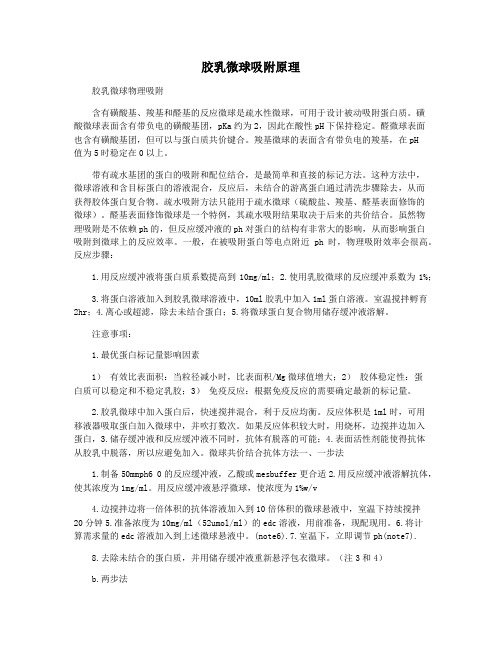
胶乳微球吸附原理胶乳微球物理吸附含有磺酸基、羧基和醛基的反应微球是疏水性微球,可用于设计被动吸附蛋白质。
磺酸微球表面含有带负电的磺酸基团,pKa约为2,因此在酸性pH下保持稳定。
醛微球表面也含有磺酸基团,但可以与蛋白质共价键合。
羧基微球的表面含有带负电的羧基,在pH值为5时稳定在0以上。
带有疏水基团的蛋白的吸附和配位结合,是最简单和直接的标记方法。
这种方法中,微球溶液和含目标蛋白的溶液混合,反应后,未结合的游离蛋白通过清洗步骤除去,从而获得胶体蛋白复合物。
疏水吸附方法只能用于疏水微球(硫酸盐、羧基、醛基表面修饰的微球)。
醛基表面修饰微球是一个特例,其疏水吸附结果取决于后来的共价结合。
虽然物理吸附是不依赖ph的,但反应缓冲液的ph对蛋白的结构有非常大的影响,从而影响蛋白吸附到微球上的反应效率。
一般,在被吸附蛋白等电点附近ph时,物理吸附效率会很高。
反应步骤:1.用反应缓冲液将蛋白质系数提高到10mg/ml;2.使用乳胶微球的反应缓冲系数为1%;3.将蛋白溶液加入到胶乳微球溶液中,10ml胶乳中加入1ml蛋白溶液。
室温搅拌孵育2hr;4.离心或超滤,除去未结合蛋白;5.将微球蛋白复合物用储存缓冲液溶解。
注意事项:1.最优蛋白标记量影响因素1)有效比表面积:当粒径减小时,比表面积/Mg微球值增大;2)胶体稳定性:蛋白质可以稳定和不稳定乳胶;3)免疫反应:根据免疫反应的需要确定最新的标记量。
2.胶乳微球中加入蛋白后,快速搅拌混合,利于反应均衡。
反应体积是1ml时,可用移液器吸取蛋白加入微球中,并吹打数次。
如果反应体积较大时,用烧杯,边搅拌边加入蛋白,3.储存缓冲液和反应缓冲液不同时,抗体有脱落的可能;4.表面活性剂能使得抗体从胶乳中脱落,所以应避免加入。
微球共价结合抗体方法一、一步法1.制备50mmph6 0的反应缓冲液,乙酸或mesbuffer更合适2.用反应缓冲液溶解抗体,使其浓度为1mg/ml。
用反应缓冲液悬浮微球,使浓度为1%w/v4.边搅拌边将一倍体积的抗体溶液加入到10倍体积的微球悬液中,室温下持续搅拌20分钟5.准备浓度为10mg/ml(52umol/ml)的edc溶液,用前准备,现配现用。
体外诊断试剂胶乳比浊法学习
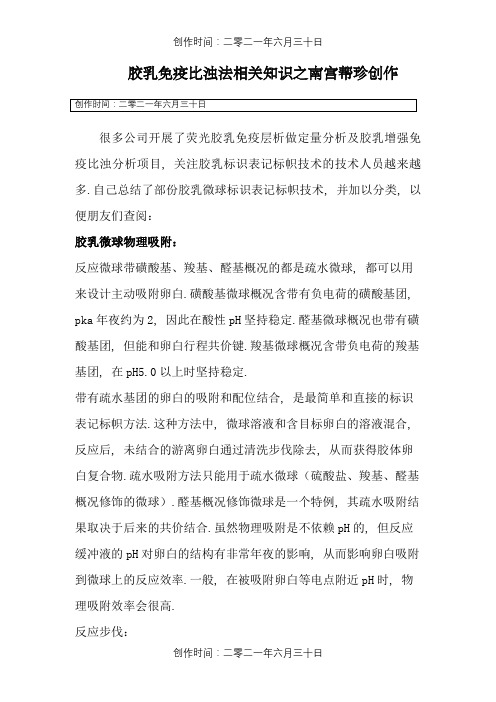
胶乳免疫比浊法相关知识之南宫帮珍创作很多公司开展了荧光胶乳免疫层析做定量分析及胶乳增强免疫比浊分析项目, 关注胶乳标识表记标帜技术的技术人员越来越多.自己总结了部份胶乳微球标识表记标帜技术, 并加以分类, 以便朋友们查阅:胶乳微球物理吸附:反应微球带磺酸基、羧基、醛基概况的都是疏水微球, 都可以用来设计主动吸附卵白.磺酸基微球概况含带有负电荷的磺酸基团, pka年夜约为2, 因此在酸性pH坚持稳定.醛基微球概况也带有磺酸基团, 但能和卵白行程共价键.羧基微球概况含带负电荷的羧基基团, 在pH5.0以上时坚持稳定.带有疏水基团的卵白的吸附和配位结合, 是最简单和直接的标识表记标帜方法.这种方法中, 微球溶液和含目标卵白的溶液混合, 反应后, 未结合的游离卵白通过清洗步伐除去, 从而获得胶体卵白复合物.疏水吸附方法只能用于疏水微球(硫酸盐、羧基、醛基概况修饰的微球).醛基概况修饰微球是一个特例, 其疏水吸附结果取决于后来的共价结合.虽然物理吸附是不依赖pH的, 但反应缓冲液的pH对卵白的结构有非常年夜的影响, 从而影响卵白吸附到微球上的反应效率.一般, 在被吸附卵白等电点附近pH时, 物理吸附效率会很高.反应步伐:1. 用反应缓冲液系数卵白到10mg/ml;2. 用反应缓冲液系数胶乳微球到1%;3. 将卵白溶液加入到胶乳微球溶液中, 10ml胶乳中加入1ml 卵白溶液.室温搅拌孵育2hr;4. 离心或超滤, 除去未结合卵白;5. 将微球卵白复合物用贮存缓冲液溶解. 注意事项:1. 最优卵白标识表记标帜量影响因素1)有效比概况积:粒径减小时, 比概况积/mg微球值得增加;2)胶体稳定性:卵白对胶乳有稳定和去稳定作用;3)免疫反应:最近标识表记标帜量由免疫反应需要决定.2. 胶乳微球中加入卵白后, 快速搅拌混合, 利于反应均衡.反应体积是1ml时, 可用移液器吸取卵白加入微球中, 并奏乐数次.如果反应体积较年夜时, 用烧杯, 边搅拌边加入卵白,3. 贮存缓冲液和反应缓冲液分歧时, 抗体有脱落的可能;4. 概况活性剂能使得抗体从胶乳中脱落, 所以应防止加入. 微球共价结合抗体方法:一、一步法1. 准备50mM pH 6.0的reaction buffer, 醋酸或MES buffer更合适2. 用reaction buffer溶解抗体, 使其浓度为1mg/mL.3. 用reaction buffer 悬浮微球, 使其浓度为1% w/v4. 边搅拌边将一倍体积的抗体溶液加入到10倍体积的微球悬液中, 室温下继续搅拌20分钟5. 准备浓度为10mg/ml(52umol/mL)的EDC溶液, 用前准备, 现配现用.6. 将计算需求量的EDC溶液加入到上述微球悬液中.(Note 6).7. 室温下, 立即调节pH (Note 7).8. 移除未结合的卵白, 并将包被微球用storage buffer重悬.(Note 3 and 4) B. 两步法为了防止EDC将相邻微球之间的卵白偶联招致微球聚集或者卵白之间交流, 两步法偶联抗体更合适.两步法中, 在卵白加入之前, 过剩的EDC被移除.两步法中, 卵白也可以使用更高pH的buffer 来溶解, 从卵白的稳定性方面和加速卵白和活化微球之间的交联速度方便考虑, 是非常有利的. B1 简单一步法:1. 准备50mM pH 6.0的活化 buffer, 醋酸或MES buffer更合适;用活化buffer 悬浮微球, 使其浓度为1% w/v 2. 每ml微球悬液加入20mg的EDC, 室温孵育20分钟, 然后再次加入20mg/mL的EDC, 继续室温孵育20分钟.(Note 7).3. 离心或超滤, 用等体积的包被缓冲液清洗两次微球, 最后悬浮在包被缓冲液中.(Note 3).4. 用包被缓冲液溶解抗体到1mg/mL, 包被缓冲液pH7~9, 浓度为50mM~100mM.(Note 1)5. 将抗体快速加入的搅拌中的微球悬液中, 继续搅拌, 室温孵育2~5小时.(Note 2).6. 每ml反应溶液中加入2.5ul的乙醇胺, 继续搅拌并室温孵育10分钟.(Note 9).7. 离心或超滤, 用贮存缓冲液悬浮, 重复两次, 移除未结合的抗体和乙醇胺.(Note 3 and 4) B2. NHS中间活化酯两步法在此方法中, 在EDAC存在下, NHS通过与微球上的羧基反应形成中间活化酯.活化酯比EDC更稳定, 不容易水解.1. 每ml反应混合物加入以下成份:? 加入DIW, 定容最终体积为1ml;? 0.1ml 10X的MES buffer, ph6.0~6.5(10X的buffer通经常使用0.5M);? 0.1ml 10%的微球(终浓度为1%);? 0.23ml NHS水溶液(50mg/mL); 11.5mg ? 一定体积的19.2mg/ml(100mM)的EDAC水溶液;2. 室温下搅拌反应15~30min;(Note7)3. 清洗:MES buffer或DIW清洗两次;(Note3);4. 用DIW冲悬浮微球到浓度为1%;5. 同时, 用包被buffer溶解稀释抗体.buffer一般为ph7~9,50mM~100mM.最终的卵白浓度1mg/mL;6. 清洗完微球后, 立即加入一定体积的抗体溶液.(Note 2).(注意:此处给出的例子, 微球浓度和卵白浓度和buffer分别为0.5%(w/v), 0.5mg/mL, 25~50mM);7. 室温下搅拌孵育2hr;8. 每ml反应液中加入 2.5ml 乙醇胺, 室温搅拌孵育10~30min;9. 清洗:storage buffer清洗两次.(Note 3/4)NOTES:1. reaction buffer的组成根据卵白种类的分歧而改变, 经常使用buffer有醋酸缓冲液、磷酸盐缓冲液、硼酸盐缓冲液、MES缓冲液.卵白在等电点附近更易于吸附到微球上, 因为在等电点附近, 卵白概况会有更多的疏水位点流露出来.在这种情况下, 抗体也更紧密, 因此需要更多的抗体用于标识表记标帜到微球上.然而, 最终 reaction buffer的选择, 需要考虑最终抗体微球复合物的生物活性, 因此, 几个分歧浓度的抗体和分歧pH的反应buffer应该进行优化选择.起始实验, 反应buffer的离子强度应该在25~50mM.2. 卵白溶液应该在快速的搅拌下, 快速加入到微球悬液中.小体积的话, 可以进行斡旋混合. 当年夜体积时, 应该在烧瓶或烧杯里搅拌剧烈些, 卵白溶液快速加入到漩涡中间.3. 移除未结合的化合物或卵白, 如果颗粒直径年夜于0.2um,可以通过离心的方法, 微球可以重新悬浮, 然后搅拌, 接着温和的超声分散.离心力不宜过年夜, 这样会招致微球不容易分散.也可以用超滤或透析来纯化.当用超滤时, 滤膜孔径应该足够年夜, 使得游离的卵白能自由的通过滤膜.用于清洗微球的buffer应该和storage buffer一样.用于清洗的buffer的任何缓冲液成份及pH的改变, 城市引起卵白的脱落.4. 微球包被抗体后, 加入概况活性剂或者去污活性成份, 可能会招致抗体脱落.如果是共价结合到微球上, 共价结合的抗体就不会有脱落现象发生.封闭卵白, 像BSA, casein 或gelatin可以用来封阻任何空余的疏水性位点, 防止微球发生非特异性凝集.可是概况活性剂可以将那些共价结合不牢固的抗体洗脱下来.5. 此试剂和水反应, 因此, 溶解后应立刻使用失落.6. EDC的用量, 根据微球概况羧基浓度来计算.根据计算所需量, 每mol的羧基应该再多加2~3mol的EDC.可是, 根据功能性检测结果, 还需要进一步的优化.7. 此步伐, 微球的凝集经常能观察到.因为接下来的步伐中, EDC会将相邻两个微球上的抗体连接起来从而引起微球凝集或者中和微球概况的羧基或者两者情况都发生.调节pH到6.5或超越6.5, 优化共价反应, 对微球的分散有帮手.如果反应结束后微球凝集现象仍然发生, 用新鲜的buffer清洗除去过剩的EDC和游离的卵白, 一般会使得凝集颗粒再分散.如果在最终的产物中凝集依然发生, 检验考试稀释微球, 一开始可以稀释到原来的50%浓度.如果稀释后凝集依然发生, 可以检验考试在所有reaction buffer中加入Tween20或Tergitol NP9等非离子型概况活性剂.这些概况活性剂不会干扰颗粒的活性或共价结合, 可是需要注意的是, 要确保在这种去污剂存在下微球共价结合的抗体的稳定.9. 加入乙醇胺, 可以和加入卵白反应后过剩的羧基位基团反应.胶乳标识表记标帜过程中罕见问题:1)问题:卵白无法吸附到微球上. 解决方法:加入更多的卵白;去除微球中的概况活性剂, 释放其占据的卵白结合位点;引入中间物, 将微球与卵白相连;改变缓冲液. 2)问题:标识表记标帜时加入了年夜量的卵白, 可是仍然无活性. 解决方法:改变卵白加入量, 从而改变卵白与微球结合的空间构象;使用表位稀释物, 占据微球上的部份卵白结合位点, 防止卵白靠的太近. 3)问题:清洗去除未吸附卵白后, 微球聚集. 解决方法:增加卵白标识表记标帜量或封闭剂的用量, 防止有空余位点;4)问题:标识表记标帜后开始活性很好, 贮存一段时间后, 活性降低. 解决方法:降低贮存温度到2~8度;降低贮存液中的封闭剂浓度, 防止抗体被替换;确认贮存液中无能与抗体竞争的杂质, 防止长时间取代抗体.5)PS微球与卵白(抗体)交联后, 那时没发现有凝集, 但隔夜后发现有凝集是偶联效率低的原因.当体系卵白缺乏或是其它原因, 使微球概况在交联后还空出许多反应基团时, 由于这些基团又可以与相连微球上的卵白反应, 结果是把球又拉在一起了, 所以有聚集.可以加一些blocker agents 解决,罕见的是BSA, 另外, 也可提高微球的交联率. 但为什么是过一段时间后才呈现凝集呢, 这是因为微球偶联上卵白后, 相互之间由于携携同种电荷的关系, 比力稳定(所以能以胶体样存在), 只有当偶尔相互碰撞, 遇上彼此的反应基团时才华结合. 6)抗体偶联至羧基PS球, 即时检测效果很好, 但置于37度 2天后, 抗体活性似乎下降很年夜. 可能共价结合未胜利, 如果是这样, 那么最主要的原因是EDAC质量差或过期了.EDAC长期放在空气中会吸潮, 水汽会降低EDAC活性. 另一个可能原因是凝集.观察胶乳是否有凝集发生.还有, 交联卵白前有没有清洗?我们提供的胶乳缓冲液中含有概况活性剂, 可能干扰抗体的结合.如果未发生凝集, 而且用前已经清洗, 那么我们建议换新的EDAC.7)EDC活化羧基乳胶微球后, 加卵白(抗体)即时有沉淀呈现, 是什么原因?很多因素可以招致卵白加入后, 微球聚集成块.通常, 卵白偶联前的聚集与缓冲液(电解质)有关. 可能是羧基没有活化好.EDC质量呈现问题了, 请换质量好的再检验考试.如果没有好的EDC, 可以适当调低活化缓冲液的pH值. 对非修饰微球, 那么可以从以下方面着手解决:绝年夜多的微球制备过程中, 加有脂肪酸乳化剂.在聚合时, 它起乳化作用, 在聚合后, 它起稳定剂作用, 使微球以胶体样分布.在碱性pH下, 微球概况的COOH, 脂肪酸分子上的COOH以及聚苯乙烯多聚链末真个硫酸根(SO42-)使微球概况带负电荷, 亲水性增强, 从而能形成稳定的胶体. 由缓冲液招致的聚集可以通过加卵白, 阴离子乳化剂, 非离子乳化剂(如Triton X-100和Tween-20). 下列方法供参考:a) 加入卵白前, 加少量的乳化剂.具体量可以自己摸索掌握, 太多的乳化剂可能会占据微球概况, 影响卵白偶联b) 少数研究人员选择用含少量卵白的缓冲液冲刷微球(可以降低体系中的离子强度)c) 适当降低缓冲液的浓度, 但不能使卵白变性.d) 稀释微球, 使微球间距离加年夜, 减少相互结合的机会e) 如果有可能, 加年夜偶联卵白的浓度f) 偶联时, 将微球加入卵白液中, 而不是将卵白加入微球中g) 偶联时, 振荡加快反应总之, 其原则是在微球与卵白偶联前, 减少其在高离子强度下与其它微球接触的机会.在偶联结束后, 由于微球概况接有的卵白, 会非常稳定.。
胶乳微球的选择

TechNote 201AMicrosphere Selection9025 Technology Dr. • Fishers, IN 46038-2886800.387.0672 • 317.570.7020 • Fax 317.570.7034info@ • ContentsI. Introduction II. Diameter III. Composition IV. CoatingA. AdsorptionB. Covalent CouplingC. Affinity Binding V. Special PropertiesI. IntroduCtIonMicrospheres offer a highly convenient and flexible system for developing reagents for assays and bioseparations, and for use as instrument standards. As there are many varieties of microspheres available, it is important to think about the demands the application will place on them when making a base bead selection. Physical and optical properties should be considered in the context of handling and detection, and thought should also be given to requirements for diameter and size distribution, composition, surface chemistry, and any other needed properties.II. dIameterMicrosphere size may be critical to the proper function of an assay, or it may be secondary to other characteristics. Considering traditional diagnosticmethods, the test or assay format commonly dictates particle size, such as the use of very small spheres (~0.1-0.4µm) to ensure satisfactory wicking in lateral flow tests, or the use of larger, cell-sized spheres (~4-10µm) for bead-based flow cytometric assays. Also see application-specific TechNotes 301-304.In magnetic separations, particularly those involving capture and elution of the target, the exact size of the magnetic particle may be unimportant provided that the particles are in some general size range, and offer desired separation characteristics. See TechNote 102 for additional details regarding our three magnetic particle lines.Diameter also determines surface area. Small-diameter spheres present more surface area per unit weight, while larger spheres present more surface area per bead. Size also affects ease of handling, processing considerations (such as the method used for separations [centrifugation, dialysis, filtration]), and the amount of reagent needed for coating.III. ComposItIonCommon microsphere compositions include polystyrene (PS), poly(methyl methacrylate) (PMMA), and silica. These materials possess different physical and optical properties, which may present advantages or limitations for different applications.Polymer beads are generally hydrophobic, and as such, have high protein binding abilities. However, they often require the use of some surfactant (e.g. 0.01-0.1% Tween ® 20 or SDS) in the storage buffer to ensure ease of handling. During synthesis, functional monomers may be co-polymerized with styrene or methyl methacrylate to develop beads with surface reactive groups. Functional groups may be used in covalent binding reactions, and also aid in stabilizing the suspension.Silica microspheres are inherently hydrophilic and negatively charged. Consequently, aqueous silica suspensions rarely require use of surfactants or other stabilizers. Carboxyl- and amine-functionalized silica spheres are available for use in common covalent coating protocols, and plain silica microspheres may be modified using a variety of silanes to generate functional groups or alter surface properties.IV. CoatIngMicrospheres may be coated with capture molecules, such as antibodies, oligonucleotides, peptides, etc. for use in diagnostic or separation applications. Microsphere coatings are typically optimized to achieve desired specific activity, while minimizing nonspecific interactions. Consideration should also be given to the required stability, development time frame and budget, and the specific biomolecule to be coated. These factors will aid in determining the most fitting coating strategy for both short- and long-term objectives.Standard microsphere products support three basic coating strategies: adsorption, covalent coupling, and affinity binding.A. AdsorptionAdsorption relies primarily on hydrophobic interactions between the biomolecule and the polymer particle. Such coatings are fairly simpleto conduct, involving incubation of the microspheres with the purified biomolecule. They typically require little optimization, and reagents may be developed relatively quickly. However, as adsorption relies on the formation of multiple attachment points between the molecule and particle, this strategy is typically reserved for use with proteins and non-functionalized polymer spheres. Adsorption is generally not suitable for hormones, peptides, or nucleic acids in hybridization-based applications, and protein adsorption to silica is expected to be less efficient than to polymer. See TechNotes 201 and 204.B. Covalent CouplingCovalent coupling results in the permanent attachment of the molecule to the functionalized (e.g. carboxyl or amine) microsphere. It can provide needed stability when developing a commercial reagent, and for multiplexed assays, where analyte-specific bead populations are mixed. Additionally, specialized chemical linkers may be employed to address steric effects or to optimally orient the molecule. Although covalent binding protocols often involve a higher level of optimization than other approaches, coupling kits are available to simplify the process. See TechNotes 201 and 205.C. Affinity BindingAffinity binding is a straightforward method for immobilizing primary antibodies or biotinylated molecules. Proteins A and G and Fc-specific antibody coatings permit the directed immobilization of primary antibodies, and streptavidin is used extensively for the binding of biotinylated molecules, such as antibodies, peptides, and oligonucleotides. See TechNotes 101 and 302.It is important to note that each binding strategy has benefits and limitations, which should be weighed in the context of study objectives and the demands that will be placed on the finished reagent.V. speCIal propertIesMany applications in the life sciences demand added properties, suchas fluorescence or a visible color, or iron oxide inclusions for magnetic separations. Polymer spheres (and polymer-based magnetic spheres)are often internally dyed via organic solvent swelling, and many standard products are available. Dye concentrations can be adjusted to produce beads with different intensities to meet special needs, such as QuantumPlex™for multiplexed flow cytometric assays, or our Dragon Green or Flash Red Intensity Standards, which support imaging applications and associated instrument QC. Many surface- or internally-labeled fluorescent beads are also available as specialized flow cytometry standards.Various types of superparamagnetic microparticles are available as well– with different matrices, magnetite content, surface groups, etc. For new assays or applications, magnetic beads should be evaluated with application demands in mind.The following tables provide product suggestions for common microsphere applications. These are offered as general guidelines only. Further literature research and screening experiments may be appropriate.BioMag® and ProMag™ are trademarks or registered trademarks of Polysciences, Inc.COMPEL™ and QuantumPlex™ are trademarks of Bangs Laboratories, Inc. Tween® is a registered trademark of ICI Americas, Inc.Copyright 2008, Bangs Laboratories, Inc.All Rights Reserved。
几种不同微球合成方法的比较
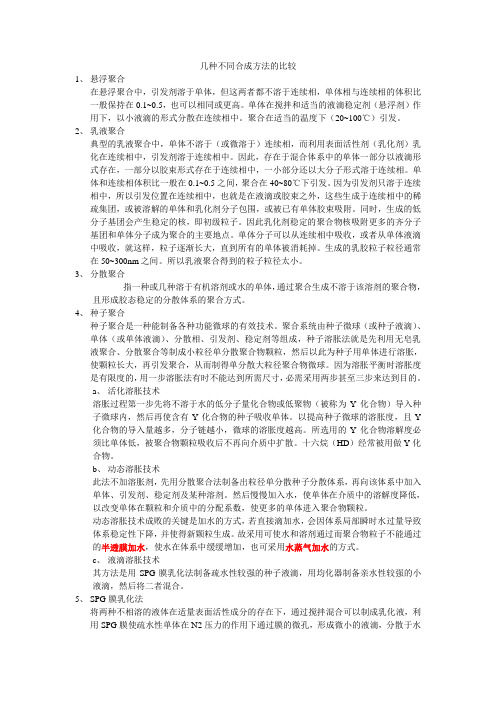
几种不同合成方法的比较1、悬浮聚合在悬浮聚合中,引发剂溶于单体,但这两者都不溶于连续相,单体相与连续相的体积比一般保持在0.1~0.5,也可以相同或更高。
单体在搅拌和适当的液滴稳定剂(悬浮剂)作用下,以小液滴的形式分散在连续相中。
聚合在适当的温度下(20~100℃)引发。
2、乳液聚合典型的乳液聚合中,单体不溶于(或微溶于)连续相,而利用表面活性剂(乳化剂)乳化在连续相中,引发剂溶于连续相中。
因此,存在于混合体系中的单体一部分以液滴形式存在,一部分以胶束形式存在于连续相中,一小部分还以大分子形式溶于连续相。
单体和连续相体积比一般在0.1~0.5之间,聚合在40~80℃下引发。
因为引发剂只溶于连续相中,所以引发位置在连续相中,也就是在液滴或胶束之外,这些生成于连续相中的稀疏集团,或被溶解的单体和乳化剂分子包围,或被已有单体胶束吸附。
同时,生成的低分子基团会产生稳定的核,即初级粒子。
因此乳化剂稳定的聚合物核吸附更多的齐分子基团和单体分子成为聚合的主要地点。
单体分子可以从连续相中吸收,或者从单体液滴中吸收,就这样,粒子逐渐长大,直到所有的单体被消耗掉。
生成的乳胶粒子粒径通常在50~300nm之间。
所以乳液聚合得到的粒子粒径太小。
3、分散聚合指一种或几种溶于有机溶剂或水的单体,通过聚合生成不溶于该溶剂的聚合物,且形成胶态稳定的分散体系的聚合方式。
4、种子聚合种子聚合是一种能制备各种功能微球的有效技术。
聚合系统由种子微球(或种子液滴)、单体(或单体液滴)、分散相、引发剂、稳定剂等组成,种子溶胀法就是先利用无皂乳液聚合、分散聚合等制成小粒径单分散聚合物颗粒,然后以此为种子用单体进行溶胀,使颗粒长大,再引发聚合,从而制得单分散大粒径聚合物微球。
因为溶胀平衡时溶胀度是有限度的,用一步溶胀法有时不能达到所需尺寸,必需采用两步甚至三步来达到目的。
a、活化溶胀技术溶胀过程第一步先将不溶于水的低分子量化合物或低聚物(被称为Y化合物)导入种子微球内,然后再使含有Y化合物的种子吸收单体。
0.5μm乳胶微粒粒度标准物质

0.5μm乳胶微粒粒度标准物质
0.5μm乳胶微粒粒度标准物质是一种用于粒度测试和校准的标准物质。
它由一系列平均粒径为0.5μm的乳胶微粒组成,这些微粒的尺寸分布符合特定的标准要求。
乳胶微粒粒度标准物质通常用于验证和校准粒度分析仪器和方法的准确性。
在粒度分析中,乳胶微粒的尺寸可以通过光散射、激光粒度仪或其他粒度测试仪器进行测量。
乳胶微粒粒度标准物质的制备通常包括以下步骤:
1. 选择合适的乳胶微粒作为原料,确保其尺寸分布符合要求。
2. 对乳胶微粒进行表面处理,以增加其稳定性和分散性。
3. 通过稀释和混合等方法,制备出一系列具有不同浓度的乳胶微粒悬浮液。
4. 使用粒度分析仪器对乳胶微粒悬浮液进行粒度测试,确定其平均粒径和尺寸分布。
5. 根据测试结果,选择符合要求的乳胶微粒悬浮液作为标准物质。
乳胶微粒粒度标准物质的应用范围广泛,包括医药、食品、化妆品、涂料、颜料等行业。
通过使用标准物质进行校准,可以确保粒度分析结果的准确性和可比性,提高产品质量控制的可靠性。
明胶微球的制备及其粒径影响因素的研究

明胶微球的制备及其粒径影响因素的研究
近年来,聚合物微球被广泛应用于生物医学、环境保护与化学反
应加速等领域,而其关键技术之一为明胶微球的制备,因此,本文研
究了明胶微球的制备及其粒径影响因素。
首先,在选择聚合材料时,包括聚合物及聚合物的浓度/体积比
都是影响微球粒径的关键因素。
不同的聚合物结构具有不同的形态稳
定性,聚合物的浓度越高,分解聚合物的能量就越高,因而球形微球
的粒径就越大。
此外,改变聚合浓度也可改变其粒径:当浓度较高时,球的粒径表现出递增的趋势;而当浓度较低时,球的粒径则是基本恒
定的。
其次,核壳比例也是影响明胶微球粒径的因素,壳部分越厚,微
球粒径就越大;反之,壳部分越薄,微球粒径就越小。
此外,溶剂、助剂及混合液稳定剂也可影响微球粒径,高亲水性
溶剂会影响其形态稳定性、改变电场等,以及影响粒径的大小。
而助
剂(如表面活性剂)能够改变溶液的空间结构,并有助于形成聚集体
的稳定性,从而促进微球粒径的形成。
此外,溶液稳定剂可以与聚合
物部分结合而形成聚集体,稳定被体系分散,有效地降低微球粒径。
综上所述,明胶微球的粒径影响因素包括聚合材料、核壳比例、
溶剂、助剂及混合液稳定剂等,对这些影响因素的控制能够优化微球
粒径,进而提高明胶微球的性能。
乳胶免疫比浊法 一般微球粒径

乳胶免疫比浊法一般微球粒径乳胶免疫比浊法是一种常用的生物分析方法,用于测定微球的粒径。
微球粒径是指微球的直径大小,通常以纳米为单位进行表示。
本文将介绍乳胶免疫比浊法的原理和应用,并探讨微球粒径对其结果的影响。
乳胶免疫比浊法是基于光散射原理的一种测量微球粒径的方法。
乳胶免疫比浊法利用乳胶微球与抗原或抗体的特异性结合作用,形成免疫复合物。
当溶液中存在免疫复合物时,免疫复合物会引起光散射现象,导致溶液的浊度增加。
通过测量光散射的强度,可以推算出微球的粒径大小。
乳胶免疫比浊法的原理是基于光散射现象,光线在经过溶液中的微球时,会发生散射。
根据洛伦兹—玛歇尔散射公式,散射强度与粒径的平方成正比。
因此,可以通过测量散射光的强度来推算微球的粒径大小。
乳胶免疫比浊法的应用非常广泛。
在生物医学领域,乳胶免疫比浊法常用于检测血清中的生物标志物,如蛋白质、抗体等。
通过测量免疫复合物的浊度,可以判断血清中特定生物标志物的含量。
这对于疾病的诊断和治疗具有重要意义。
除了生物医学领域,乳胶免疫比浊法还可以应用于其他领域。
例如,乳胶免疫比浊法可以用于环境监测,检测水体中的微生物污染。
同时,乳胶免疫比浊法还可以用于食品安全检测,快速检测食品中的有害菌和毒素。
微球粒径是乳胶免疫比浊法中一个非常重要的参数。
微球的粒径大小直接影响到光散射的强度,从而影响到测量结果的准确性。
因此,在进行乳胶免疫比浊法实验时,需要选择合适大小的微球。
过小的微球可能导致测量结果不稳定或无法观察到光散射现象,而过大的微球则可能导致光散射过强,超出测量范围。
溶液的浓度和pH值也会对乳胶免疫比浊法的结果产生影响。
溶液过浓或过稀会导致光散射强度的变化,从而影响到测量的准确性。
pH值的改变也会影响到溶液中微球的稳定性和免疫复合物的形成,进而影响到测量结果。
乳胶免疫比浊法是一种常用的生物分析方法,用于测定微球的粒径。
通过测量光散射的强度,可以推算出微球的粒径大小。
乳胶免疫比浊法在生物医学、环境监测和食品安全等领域具有广泛应用。
plga微球最佳粒径_概述说明以及解释
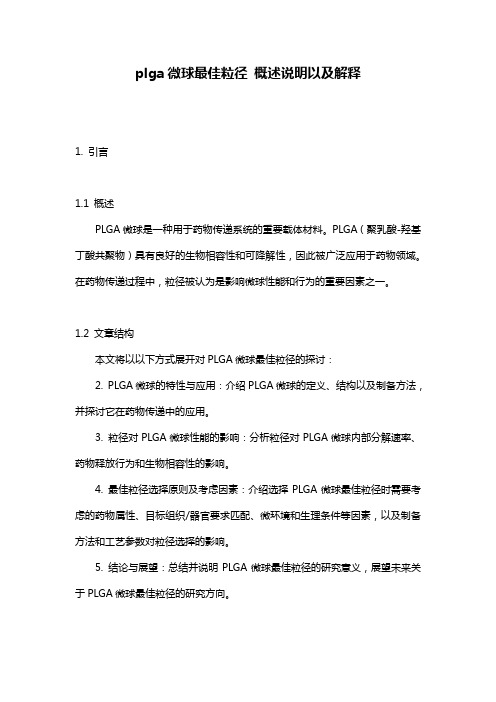
plga微球最佳粒径概述说明以及解释1. 引言1.1 概述PLGA微球是一种用于药物传递系统的重要载体材料。
PLGA(聚乳酸-羟基丁酸共聚物)具有良好的生物相容性和可降解性,因此被广泛应用于药物领域。
在药物传递过程中,粒径被认为是影响微球性能和行为的重要因素之一。
1.2 文章结构本文将以以下方式展开对PLGA微球最佳粒径的探讨:2. PLGA微球的特性与应用:介绍PLGA微球的定义、结构以及制备方法,并探讨它在药物传递中的应用。
3. 粒径对PLGA微球性能的影响:分析粒径对PLGA微球内部分解速率、药物释放行为和生物相容性的影响。
4. 最佳粒径选择原则及考虑因素:介绍选择PLGA微球最佳粒径时需要考虑的药物属性、目标组织/器官要求匹配、微环境和生理条件等因素,以及制备方法和工艺参数对粒径选择的影响。
5. 结论与展望:总结并说明PLGA微球最佳粒径的研究意义,展望未来关于PLGA微球最佳粒径的研究方向。
1.3 目的本文旨在全面概述和解释PLGA微球最佳粒径的研究现状,并对其选择原则及考虑因素进行分析和总结,以期为PLGA微球在药物传递领域的进一步应用和优化提供参考依据。
2. PLGA微球的特性与应用2.1 PLGA微球的定义与结构PLGA微球是由聚乳酸-羟基丙酸-聚乳酸(PLGA)共聚物制成的微小颗粒。
它具有多孔性和可调控的内部结构,在外观上呈现为球形或近似球形。
2.2 PLGA微球的制备方法制备PLGA微球最常用的方法包括沉淀/溶剂挥发法、乳化-溶剂挥发法和水油乳液法等。
其中,沉淀/溶剂挥发法是最简单和广泛使用的方法之一,通过将PLGA 溶解在有机溶剂中,再通过添加非溶解于该有机相中的极性非溶剂使PLGA产生沉淀,并在后续步骤中将有机溶剂完全挥发,得到PLGA微球。
2.3 PLGA微球在药物传递中的应用由于其优异的特性,PLGA微球被广泛应用于药物传递系统中。
首先,由于其多孔结构和大表面积,PLGA微球可以提供高载药量并实现持续释放。
- 1、下载文档前请自行甄别文档内容的完整性,平台不提供额外的编辑、内容补充、找答案等附加服务。
- 2、"仅部分预览"的文档,不可在线预览部分如存在完整性等问题,可反馈申请退款(可完整预览的文档不适用该条件!)。
- 3、如文档侵犯您的权益,请联系客服反馈,我们会尽快为您处理(人工客服工作时间:9:00-18:30)。
<< COPY >>ContentsI. IntroductionII. Our Sizing MethodsA. Dynamic Light ScatteringB. Coulter Principle III. Optical Microscopy IV. Other MethodsV. ReferencesI. IntroduCtIonSizing is an important type of particle analysis for applications in the lifesciences. Establishing microsphere size allows us to predict particle behavior (movement in solution, settling time), calculate surface area available for binding, and determine the best methods for handling (e.g. performance ofseparations). Sizing is also a useful tool for monitoring certain aspects ofmicrosphere synthesis and modification processes.There are many different techniques that may be used to size particles, each with its own set of benefits and limitations. We believe that the analytical methods employed by Bangs Laboratories are the most effective for meeting both customer needs and our internal requirements, considering quality of results (accuracy, reproducibility), dynamic range, and cost. We selected sizing instruments after an extensive research and screening process. Our measurement systems have been qualified through gage studies, and continued capability is ensured through regular calibration and servicing of the instruments and operator training.II. our sIzIng MethodsA. Dynamic Light Scattering Note: Also termed Photon Correlation Spectroscopy or Quasi-Elastic LightScattering.A great number of particle sizing instruments rely on the phenomenon oflight scattering. Basic components of these types of instruments include a laser, a detector, and a correlator. An explanation of the theory in very general Bangs Laboratories, Inc.TechNote 208Rev. #003, Active: 19/March/2013Page 1 of 2terms is as follows: Light that passes through a suspension of particles loses intensity due to its scattering and absorption by the particles. Scattered light from the particles reaches the detector, and is observed as intensity fluctuations about some average value (Figure 1). The correlator relates thesefluctuations in intensity to a particle size.reports only mean diameter values for microspheres sized in this manner (this includes microspheres below ~1.5µm in diameter). However, the synthesisprocesses that we use typically produce populations with CVs ≤10% forpolymeric and ≤15% for silica, when determined by electron microscopy (TEM or SEM).B. Coulter Principle Note: Also termed Electrical Sensing Zone.Instruments employing the Coulter Principle determine microsphere size by measuring the fluid volume displaced by individual particles. Particles suspended in an electrolyte solution are pumped through an aperture (the“electrical sensing zone”) between two electrodes. The volume of electrolyte displaced by each particle is measured as a voltage pulse, the height of which is proportional to particle volume.Pa 1 ofgeneral terms is as follows: Lia suspension of particles los scattering and absorption by t light from the particles reach observed as intensity f uctuatio value Figure 1). The cf uctuations in intensity to a pa Although light scattering instr reliably determining the mean d populations,the technology d the determination of standa Laboratories thus reports only for microspheres sized in this microspheres below ~1.3µm ithe synthesis processes that w populations with CVs of less th and less than ~15% for silica electron microscopy (TEM or S ype of particle analysis sciences. Establishing o predict particle behavior ng time), calculate surface d determine best methods ce of separations). Sizingnitoring certain aspects of modif cation processes.hniques that may be used s own set of benef ts and he instrumental techniques oratories are the mostustomer and our internal uality of results (accuracy, e and cost. We selectedextensive research and asurement systems have e studies, and continued gh regular calibration and and operator training. Dynamic Light Scatteringtion Spectroscopy, or g)ing instruments rely on the ng. Basic components of nclude a laser, a detector, ation of the theory in very Fluctuations of Scattered IntensityTimeTECH NOTE 208Page 2 of 2Bangs Laboratories, Inc. TechNote 208 Rev. #003, Active: 19/March/2013<< COPY >>Our electrical sensing zone instrument is suitable for sizing and determining the distribution of populations that are relatively uniform, as upper and lower size thresholds must be set (Figure 3). This method yields highly accurate and reproducible results for both mean diameter and distribution of the population. Microspheres that are ≥ ~1.3µm are sized using this method.III. optICal MICrosCopyAlthough we depend on instrumental methods for assignment of microspheresize (and distribution, where appropriate), we continue to rely heavily upon optical microscopy as a complementary technique. All products undergo microscopic examination as a further check of product quality. For example,microscopy permits the identification of multimodal distributions (presence of significant fines or “supers,” or broad distributions) or particle irregularities that might not be evident through review of sizing histograms alone (Figures 4a and 4b).IV. other Methods In some instances, Bangs Laboratories relies on other methods of sizing (e.g. electron or optical microscopy). The method of sizing used is reported on the Certificate of Analysis that accompanies each product shipment.V. referenCes 1. Beckman Coulter. 2003. .2. Brookhaven Instruments Corporation. 2003. .3. Karuhn, R.F. 2002. Modern concepts of particle characterization. The Latex Course, Indianapolis, IN.4. Murphy, C.H. 1984. Handbook of particle sampling and analysismethods. Deerfield Beach: Verlag Chimie International.Copyright 2003, Bangs Laboratories, Inc.All Rights ReservedPa 2 ofzone instrument is suitable fothe distribution of populationorm, as upper and lower size (Figure 3). This method yield reproducible results for both distribution of the population≥ ~1.3µm are sized using thi py on instrumental methods fo sphere size (and distribution e continue to rely heavily upon a complementary technique. Aoscopic examination as a furtheity. For example, microscop on of multimodaldistribution nt f nes or “supers,” or broad e irregularities that might noiew of sizing histograms alone IV.In me ThofV. Be BroKa ch Ind Mu HaAn . D Int KTCo All0pper and lower thresholds that alysis. (Coulter)Fig : Mex an fus simFigure 4a: Histogram portrays a multimodal distributionFigure 4b : Microscopic examination reveals anomalous particles: fused doublets ofsimilarly sized particles.Pa 2 ofmethod. I. Optical Microscopy lthough we depend on instrumental methods ssignment of microsphere size (and distribu where appropriate), we continue to rely heavily u ptical microscopy as a complementary technique roducts undergo microscopic examination as a fur heck of product quality. For example, microsc ermits the identif cation of multimodal distribut presence of signif cant f nes or “supers,” or b Ka ch IndMu Ha An . D Int KT CoAll: Example of upper and lower thresholds thatdef ne the window of analysis. (Coulter)Figure 3: Example of upper and lower thresholds that define the window of analysis. (Coulter)Figure 4b: Microscopic examination reveals anomalous particles: fused doublets of similarlysized particles.Pa 2Instruments employing the Coulter Principle determine the f uid volume displaced by individual particles. Particles suspended in an electrolyte solution are pumped through an aperture (the “electrical sensing zone”) between two electrodes.The volume of displaced by each particleis measured as a voltage pulse, the height of which isIV. Other Methods In some instances, Bangs Laborator methods of sizing (e.g. electron or op The method of sizing used is reported of Analysis that accompanies the pro V. References Beckman Coulter, Brookhaven Instruments Corporation Karuhn RF. “Modern concepts of pa characterization.” The Latex Course Indianapolis, IN.Murphy CH. Handbook of Particle Sa Analysis Methods . Deerf eld Beach: International. 1984.KT - AUG / 2003Copyright 2003, Bangs LaboratAll Rights Reserved0Fig : Mex an fus sim。
